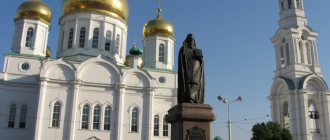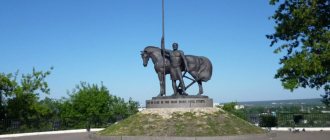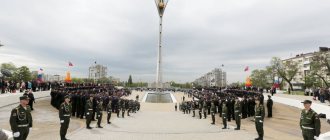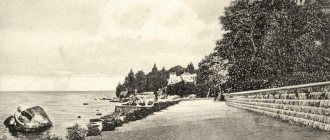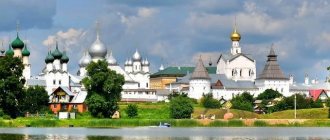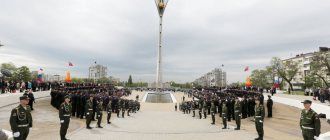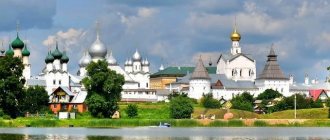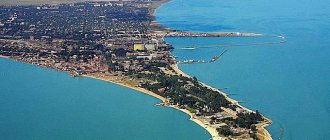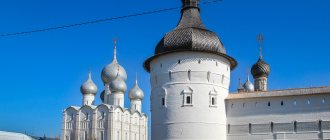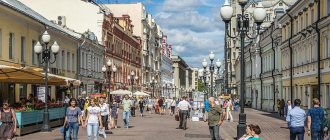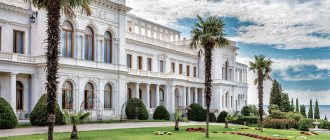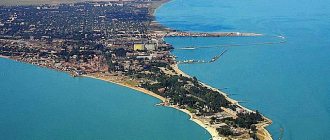Brief information about Rostov-on-Don
In 1749, Empress Elizaveta Petrovna issued a decree establishing the Temernitsa customs house. This year is considered the founding date of Rostov-on-Don. The city became an important economic point due to its location at the intersection of water and land routes. Residential buildings and retail shops were built here, and in 1926 the Rostselmash agricultural machinery plant was founded. Later, theaters and other cultural institutions opened in Rostov-on-Don. During the Great Patriotic War, German troops occupied the city in 1941 and 1942.
Rostov-on-Don has a rich history and is an important economic point
Administratively, Rostov-on-Don is divided into 8 districts. The total area of the territory is 348.5 km², and about 1,125,299 people live here. The settlement is located in the southeast of the East European Plain. The main part of the city is located on the right bank of the Don River, which provides it with access to five seas: the Black, Caspian, Baltic, White and Azov. The climate here is moderate continental. The average air temperature in winter is -2.9 °C, and in summer - about +28.3 °C.
Rostov-on-Don has an international airport, a seaport and a river station, main and suburban bus and railway stations. Several major highways pass through the city. You can move around the village by trams, metro, buses and trolleybuses. There are five bridges across the river, including for railway transport.
Entertainment
The city offers a lot of entertainment, including for extreme sports enthusiasts. Various land and water attractions are quite popular.
Ferris wheel "One Sky"
The Rostov Ferris Wheel is the third highest in the world - it rises 65 m above the ground. It offers an overview of the city within a radius of 25 km.
All 30 cabins are glazed, there are tables and soft sofas inside, designed for 6 people. The attraction can accommodate up to 180 visitors at a time.
The Ferris wheel operates all year round in any weather. Each cabin is equipped with air conditioning to cool the air in summer and heat it in winter. The attraction also has more comfortable seats - with leather chairs and music. They are often chosen by young people for romantic dates.
The lowest ticket price is on weekdays from 10.00 to 12.00. Children under 6 years old are admitted free of charge.
Water park "H2O"
The water and health complex is located on an area of 25,000 square meters. m and consists of three levels:
- On the ground floor there is a large swimming pool with imitation waves and a smooth entry into the water, Tsunami and Slow River attractions, grottoes, and a playground for children. Here you can also buy drinks in two bars.
- The second level of the water park is completely dedicated to a relaxation area: massage rooms, spa salons, cafes.
- On the third floor there is a cafe, a bathhouse, and classic swimming pools - summer and all-season.
The water park has 8 indoor and outdoor water slides. For thrill-seekers, there is the Magic Hole attraction with numerous twists and turns.
Old bazaar
This is what people call the Central Market of Rostov-on-Don, which is located on Budenovsky Prospekt. The first shopping arcades appeared here back in the 1820s, and now it is the largest market in southern Russia.
On the territory of the bazaar there are covered food areas where they sell meat, eggs, milk, vegetables and fruits, cereals, and spices. Clothes, shoes, and haberdashery are sold in the clothing area.
Market prices are quite high in the city. This is due to the expensive rental of places. But many sellers are willing to bargain and make good concessions. Trade at the market also goes on at night: products are sold in bulk at almost half the price.
Restaurant "Iveria"
The Georgian restaurant has two rooms. The main room can accommodate up to 120 people, and the veranda can accommodate 20 guests. Another 100 seats are provided under the summer tent on the street. The interior of the establishment is designed in a classic style.
The decoration of “Iveria” includes brick. Small paintings hang on the walls. The rooms are furnished with wooden tables, chairs and soft sofas. The emphasis in the interior is on muted shades.
The Iveria restaurant offers not only Georgian dishes, but also European cuisine. The menu includes first and second courses, appetizers, sauces, salads, and desserts. But people come here specifically for the national Georgian pastries: khachapuri, mchadi, chvishtari, lavash. In addition, the establishment offers a huge selection of meat, fish and vegetables cooked on the grill.
The check for lunch at Iveria ranges from 1000–1700 rubles.
How to get to Rostov-on-Don
You can get to Rostov-on-Don from Moscow and other major Russian and European cities by direct flight. It is easy to get from the passenger terminal to the city center by bus No. 7, trolleybus No. 9, minibuses No. 24, 67, 88, 95.
Many trains running to Adler, Anapa, Nalchik, Kislovodsk, Novorossiysk, Vladikavkaz, Nazran pass through Rostov-on-Don. For example, the route “Moscow - Adler” is popular. The duration of such a trip will be 16 hours. And also buses depart from Moscow that run from the Kazan bus station, the South Gate international bus station, and the Varshavskaya and Krasnogvardeyskaya bus stations.
The best attractions in the city
There are many interesting and famous objects in Rostov-on-Don that cannot be seen in a day, so before traveling you should find out the location of the most famous places.
Architectural and historical objects
Rostov-on-Don has a large number of buildings built at the end of the 19th and beginning of the 20th centuries - at that time merchants and noble people were actively settling here. Now these buildings are architectural monuments and popular among tourists:
- Paramonovsky warehouses are a complex of buildings built in the 19th century. They are located between Sokolov Avenue and Universitetsky Lane. These buildings are an architectural monument of federal significance. The facility is now in ruins;
Paramonovsky warehouses - an ancient building in ruins - The Wrangel House is a building created in 1885. One of the famous leaders of the white movement, founded in 1917–1922, Pyotr Nikolaevich Wrangel, spent his childhood and youth here. The author of the project was the architect N. A. Doroshenko. Tourists can see ancient stucco on the main façade, but the house is closed to the public. His address is Gazetny Lane, building 8;
Wrangel House is an ancient building with a rich history - The Liventsovskaya fortress was created in the 15th–14th centuries BC. e. and served as a fortification. The object was built by tribes of the North Caucasian culture. Now the fortress is in ruins. The landmark is located between the villages of Karataevo and Liventsovka in the Sovetsky district;
The Liventsovskaya fortress is in ruins and has a rich history - Paramonov's mansion, built in 1914, is made in the neoclassical style and is an architectural monument of federal significance. The library of Rostov State University is located here. The building is located on Pushkinskaya Street, 148. Many other historical objects are also located here, for example, apartment buildings, a monument to Pushkin, a city garden;
Paramonov's mansion is one of the most beautiful buildings on Pushkinskaya Street - The Martyn brothers' house, built in 1893, is located at the intersection of Krepostny Lane and Bolshaya Sadovaya Street. The red brick building has towers with a colorful roof. Now there is a branch of the State Museum-Reserve of M. A. Sholokhov. Building address: Bolshaya Sadovaya street, building 125;
The Martyn brothers' house has a beautiful design - The house of the Rostov mayor Ivan Zvorykin was built in 1914. Tourists will be interested in the object due to its beautiful architecture. Bay windows, a main entrance in the shape of a pointed arch, and attics with niches make the building graceful and elegant. House address: Pushkinskaya street, building 89/57; The house of Ivan Zvorykin is considered one of the most beautiful buildings in the city
- The Rostov TV tower was installed in 1958 and is one of the tallest structures in the city, reaching 195 meters. The tower is illuminated and looks beautiful in the dark. Object address: st. Barrikadnaya, 16;
The Rostov TV tower is one of the tallest city buildings - The Cathedral of the Nativity of the Blessed Virgin Mary was built in 1860. The snow-white stone structure has five domes, a three-tier iconostasis, and a bell tower. In front of the building is Cathedral Square, where a monument to St. Demetrius of Rostov is erected. You can see the temple on the street. Stanislavsky, 58;
The Cathedral of the Nativity of the Blessed Virgin Mary has beautiful architecture - The Bostrikins' apartment building was created in 1914 and is designed in the Art Nouveau architectural style. Balconies with openwork grilles, cladding of the first floor, decorative plaster make the building one of the most beautiful in Rostov-on-Don. Nowadays a bank branch is located here, but tourists can admire the architecture of the building from the outside while walking around the city. The attraction is located on Pushkinskaya Street, 106;
The Bostrikins' apartment building has elegant architecture and is located near the city center - The Yablokov trading house was built in 1898. Graceful bas-reliefs, large window openings, and stucco decorate the building. Nowadays various commercial firms are located here. The author of the house project was the architect E.M. Gulin. Full address of the property: Bolshaya Sadovaya Street, building 64;
Commercial organizations are located in the Yablokov trading house - Rostov Arena is a sports complex built in 2022. It is designed to host football matches of the 2022 FIFA World Cup. The sports facility is equipped with bright night lighting and looks impressive on the river bank. The Levoberezhny Park was founded nearby. Object address: st. Levoberezhnaya, house No. 2B;
Rostov Arena is a large sports complex - The main building of the University of Warsaw, erected in 1914, is designed in Art Nouveau style. Now this facility is one of the buildings of the Southern Federal University. The building is located at the address: Bolshaya Sadovaya Street, building 33. You can get here by bus No. 3, 3a, 7, 67, 70, 80, 98;
The main building of the University of Warsaw is designed in Art Nouveau style - The fountain on Teatralnaya Square is the largest in Rostov-on-Don. It is surrounded by well-kept territory;
The fountain is located on the main square of the city - Teatralnaya - The Rostov Drama Theater named after M. Gorky was founded in 1863. Initially, the building was wooden, and after 20 years it was replaced with stone. The modern structure was created in 1935, but it was damaged during the Great Patriotic War. After restoration in 1963, the theater was opened to spectators. Depending on the performance, ticket prices range from 200 to 1,500 rubles. You can check the schedule, ticket prices and other features on the website of the institution, which is located on Teatralnaya Square, 1. You can get there by buses No. 3, 3a, 7, 67, 70, 80, 98, trolleybuses No. 1, 2, 9, 22 to stop “Teatralnaya Ploshchad”.
The Rostov Drama Theater named after M. Gorky delights viewers with interesting productions
Military landmarks
Fierce battles were fought in Rostov-on-Don during the Great Patriotic War. Monuments, monuments and other objects reflect this historical period:
- The stela “To the Liberators of Rostov” is located on Teatralnaya Square. The monument was inaugurated in 1983. The tower reaches 72 meters in height. At the top there is a sculpture depicting the winged goddess Nike. Night illumination makes the stele very beautiful in the dark;
The stela “Liberators of Rostov” is one of the tallest and most beautiful monuments of the city - The monument to military doctors in Rostov-on-Don is located on the territory of the Central City Hospital at Voroshilovsky Prospekt, 105/11. The sculpture was unveiled in the 1970s and depicts a young nurse carrying a wounded soldier from the battlefield;
The monument to military doctors is located on the territory of the Central City Hospital of Rostov-on-Don - The memorial complex “Fallen Warriors” is located in the Frunze park (on Karl Marx Square). This monument is dedicated not only to soldiers, but also to civilians who died during the Great Patriotic War. The sculpture is a concrete half-ring that is installed horizontally. It depicts the grieving Motherland, and there are bright flower beds around it.
The memorial complex “Fallen Warriors” is dedicated to those who died during the Great Patriotic War
The best museums in the city
The city is famous for its rich history, so there are many museums and other cultural attractions that will be of interest to travelers:
- The Museum of Fine Arts opened in 1938. The collection of exhibits includes more than 6,000 items. Visitors can see works of painting, sculpture, decorative and applied art, and graphics. The permanent exhibition presents ancient Russian art, works of the 18th - early 20th centuries, as well as creations by masters of Western Europe and the East. A separate ticket is required to view each exhibition. For example, to see the “Russian Art” collection you need to pay 110 rubles for adults, 30 rubles. — per ticket for schoolchildren, 50 rubles. - for students. Museum address: st. Pushkinskaya, 115. You can visit it from 10:00 to 18:00, closed on Tuesday;
The Museum of Fine Arts displays works from different countries - The Museum of the North Caucasus Railway is a complex that includes a museum in the Palace of Culture of Railway Workers and an open-air exhibition located at the old Gnilovskaya station, in the southwest of the city. The museum was opened in 1960. The institution's exhibitions include documents, photographs, maps, telephones and much more, and you can see all this on Guseva Street, 2. The collection, located in the open air, includes steam locomotives, diesel locomotives, tanks and other types of transport. The museum is open from Tuesday to Sunday from 10:00 to 17:00, closed on Monday. A ticket for schoolchildren costs 50 rubles, for students - 60 rubles, for adults - 100 rubles;
The Museum of the North Caucasus Railway presents various types of equipment - The Rostov Regional Museum of Local Lore presents to visitors paintings, antiques, household and handicraft items, gold and silver items of the 4th century BC. e. - VIII century AD e. and much more. The institution was founded in 1937. Now this place is popular among tourists. Scientific events and lectures are also held here. Address: st. Bolshaya Sadovaya, 79. The museum is open from Tuesday to Sunday from 10:00 to 17:30. The price of tickets and excursions can be found on the institution’s website.
The Rostov Regional Museum of Local History presents rare and interesting exhibits to visitors
Places for walking
Rostov-on-Don has a comfortable climate, so tourists should take a tour of the city and its surroundings. During such an event, you should pay attention to the following natural attractions:
- The Botanical Garden of the Southern Federal University was founded in 1927 and covers an area of about 160.5 hectares. There is not only rich vegetation here, but there is a mineral spring, which is considered an Orthodox shrine and is named in honor of St. Seraphim of Sarov. There are beautiful alleys for walking in the garden. The establishment is open from Monday to Friday from 8:00 to 18:00, and on Sunday and Saturday the garden is open from 10:00 to 18:00. A 1.5 hour excursion costs 150 rubles. for adults and 100 rub. for school age children. Children under 5 years old can visit the garden free of charge. Attraction address: lane. Botanical Descent, 7. You can get here by bus No. 37, minibuses No. 12, 20, 23, 25, 93 to the stop. "Botanical Garden", and then walk along the Botanical Descent;
There are beautiful alleys for walking in the Botanical Garden of SFU - The Kumzhenskaya Grove is famous for the fact that in 1983 a memorial dedicated to the fallen Red Army soldiers who participated in the liberation of Rostov-on-Don was erected here. A landscaped alley leads to it, and the rich vegetation of the grove makes this place beautiful and popular for walking. The grove is located on the Kumzhenskaya Spit, located on the spit of the Don and the Dead Donets;
Kumzhenskaya Grove is a picturesque place with a memorable memorial - Green Island is a piece of land located in the middle of the Don River. It is approximately 4 km long and approximately 1.5 km wide. There is a lot of meadow and tree vegetation here. Recreation centers, children's camps, and a public beach are popular among tourists and local residents. There is a fee to enter here by car, but visiting the island is free for pedestrians and cyclists.
On Green Island there are recreation centers and children's camps
Video: trip to Rostov-on-Don
Streets and architecture
The most interesting streets with iconic sights of Rostov-on-Don are located in the city center. The historical center flaunts ancient architecture. The beautiful appearance of Rostov-on-Don was formed by trading houses of merchants, classical buildings of museums and city administration, built in the 19th century.
Pushkinskaya street
One of the main streets of Rostov-on-Don stretches for almost 4 km. A relaxing atmosphere is created by walking paths surrounded by greenery, shady alleys, benches, sculptures in the form of balls and a monument to the Russian poet A.S. Pushkin.
Its unusual architectural appearance is given by ancient buildings of the late 19th – early 20th centuries: the apartment building of Vasily Kushnarev, the mansions of Pavel Kramer and Nikolai Paramonov. A small section of Pushkinskaya Street is reserved for a park area, in which there are several cafes, restaurants and shops. During the hot season, fountains gush here.
At the intersection with Nakhichevan Avenue there is a composition “Lyre” with three musical instruments on a low platform from which water gushes. Another such structure with light and sound accompaniment is located near the Don State Public Library.
Bolshaya Sadovaya
The central street of Rostov-on-Don is one of the earliest in the city. Its construction began in the middle of the 19th century. Sadovaya is compared to Nevsky Prospekt in St. Petersburg, and one of the sites with old houses is called the local Broadway.
Monuments of civil architecture are concentrated here, for example, the three-story mansion of Argutinsky-Dolgorukov with Baroque elements: sandriks, attics, frames and stucco.
The building of the former Volzhsko-Kama Bank, built in the Art Nouveau style, is also interesting on Sadovaya Street. The facade is decorated with masks, arches, attics, and stucco. There are huge windows on the second floor, and small balconies made of metal on the third. Today the house houses the Palace of Children and Youth Creativity.
Trading house Gench-Ogluev
The apartment building of the merchant Gench-Ogluev was built in 1883 and became the first “high-rise” in the city. External and internal decoration is predominantly in an eclectic style.
Excluding the attic and basement, the building has 3 floors. The structure ends with a multi-pitched roof with a superstructure, which after the Great Patriotic War was restored in a modified form: the tent on the tower was reduced, the spire was removed and dormer windows were made.
The main facade of the trading house is decorated in the Baroque spirit. The large windows on the ground floor, designed as shop windows, catch your eye. On the second and third floors the openings are rectangular, in some places they are supplemented with sandstones.
There are two entrances to the building: one is made from the facade and has the shape of an arch, and the other is located on a beveled corner - under a two-tier bay window.
City Council building
The house was built in 1899 for a meeting of the local council. During Soviet times, the regional committee of the CPSU worked there, and today the Rostov City Hall is located here.
The building is designed in the spirit of eclecticism with Baroque elements: stucco, masks on the facade with the image of ancient goddesses, capitals with women's faces, caryatids under the balconies.
The City Council building has 4 floors, and above them there are small domes. They were returned to their place during reconstruction. A characteristic feature of the house is the windows of different sizes and shapes: rectangular, round, square.
Only City Hall employees are allowed inside the City Council building - you can only admire it from the outside.
River Station
On the territory of the river station there is a two-story building built in 1977 to serve passengers of cruise ships arriving in Rostov-on-Don. In its shape, it itself resembles a river boat - with galleries and transitional ramps. The terminal is made primarily of concrete and glass.
The complex includes the former 11-story Anchor Hotel, adjacent to the passenger building. As conceived by the authors of the project, it was supposed to resemble a captain's bridge for observing the river. Now its premises are rented out to restaurants, shops and travel agencies.
From Rostov, cruise ships depart to Yeisk, Astrakhan, Samara, Volgograd and Moscow.
Travel at different times of the year
In mid-summer, the air temperature in Rostov-on-Don can reach +35 °C. The beginning of the season is more favorable, as the air warms up to +20 °C - at this time you can take a river cruise, but city attractions are no less interesting. For example, it is worth looking at the house of the merchant Gench-Ogluev. The building was built in 1883 and features an eclectic architectural style. The object is located at: Bolshaya Sadovaya Street, building 68. There are many beautiful houses on this street, so a walk here will be interesting.
The house of the merchant Gench-Ogluev is distinguished by its elegant architecture and rich history
In autumn, the air temperature gradually drops, and in October the daily average is +15 °C. At this time of year it is especially beautiful in the October Revolution Park. It was founded in 1926, covers an area of 17 hectares and is located next to Teatralnaya Square. Cultural events are held here on holidays, and the Ferris wheel and other attractions provide a fun-filled holiday. The park's alleys are decorated with elegant sculptural compositions.
Cultural and entertainment events are often held in the October Revolution Park
In winter, the average air temperature is -3 °C. At this time, the weather is changeable, for example, it often snows or rains, so tourists should take time to get acquainted with the cultural attractions of the city. One of these places is the Rostov Musical Theatre, founded in 1999. It is known as one of the largest institutions of this type in the South of Russia. Nowadays interesting performances with the participation of famous artists are held here. The theater is located on Bolshaya Sadovaya, 134. It is open every day from 10:00 to 22:00. Ticket prices depend on the performance, and you can find out more information on the theater’s website.
The Rostov Musical Theater hosts interesting productions
In the spring, Rostov-on-Don gradually gets warmer, and in April the average air temperature is more than +10 °C. Travelers can take a walk in warm weather along the Don River embankment, which offers a beautiful view of the other bank. This place is popular for relaxation among locals and tourists. Sculptures, elegant lanterns and flower beds decorate the embankment. Here is also the monument “Rostovchanka”, skillfully made by sculptor A. A. Sknarin.
The Don River embankment is popular for walking among tourists and local residents
A trip to Rostov-on-Don can be made at any time of the year, but the most comfortable trip is in the summer or spring, as well as in early autumn. In winter there is often wet snow and walking will not be comfortable.
Cathedral of the Nativity of the Blessed Virgin Mary
Rostov Cathedral in the Name of the Nativity of the Blessed Virgin Mary. Photo: Vadim Anokhin / photobank “Lori”
The Cathedral of the Nativity of the Blessed Virgin Mary - the main church of the Rostov diocese - is a smaller copy of the Cathedral of Christ the Savior in Moscow. It was erected in the 1860s by Konstantin Ton, the author of the capital’s temple, the founder of the “Russian-Byzantine” style, which was popular in Russia in the mid-19th century. In 1937, a zoo and a warehouse were organized on the premises of the cathedral, but five years later, during the war years, services in the temple resumed and the building was renovated. In 1999, the bell tower of the cathedral was also restored. Nowadays, as in the old days, Cathedral Square is located in front of the temple.
Interesting for children
In modern and beautiful Rostov-on-Don there are many places where an exciting and useful holiday is possible for children and adults:
- The DonPark water park, opened in 2014, is a popular place for recreation and entertainment. It is located on the shores of Salt Lake and includes about 40 attractions and water slides, 2 heated pools and 2 regular ones, a jacuzzi, a cafe and much more. Water park address: Rostov region, Bataysk, Vostochnoe highway, 7/3. To visit here, you first need to get to the suburban railway station of Rostov-on-Don, which is located on Privokzalnaya Square, 2/1 (buses No. 3, 3a, 7, 31, 67, 98, 109 run to the Prigorodny Station stop, 113, 133 and 516). After this, you need to transfer to bus No. 109 or 133, going to the Salt Lake station in the city of Bataysk. It’s easy to check the cost on the water park’s website;
The DonPark water park is in demand for recreation and is a modern entertainment facility - The Rostov Dolphinarium was founded in 2009. The institution has 3 swimming pools, spectator stands and beautiful scenery. The show features dolphins, fur seals, beluga sturgeon and walruses. Here you can buy souvenirs, purchase photos of artists with animals, and have a snack in a cafe. Dolphinarium address: Kommunistichesky Ave., 36/4. It is easy to get to the place by buses No. 34, 57, 94, 96, 98 and minibuses No. 10, 20, 25, 34, 73, 93, 94, 96, 98 (stop “Park Skazka”). Opening hours and prices vary depending on the season. You can find out more information on the dolphinarium website;
The Rostov Dolphinarium regularly hosts interesting shows for children and adults - The Rostov Museum of Cosmonautics was founded in 2009. Here you can watch films about the work and life of people in orbit, see personal belongings of astronauts, documents and photographs, navigation instruments, suits and much more. Museum address: Stachki Avenue, 231/2. You can get there by buses No. 16, 64, 158A, 457 and minibuses No. 16, 23 and 25 (stop “Strachki, 231”). You can visit the museum any day from 9:00 to 16:00. A ticket for adults costs 250 rubles, for children - 150 rubles. This price includes a demonstration of video materials. Photography in the museum costs 250 rubles, for video filming you need to pay 450 rubles;
The Rostov Museum of Cosmonautics includes many interesting exhibits - The Rostov-on-Don Zoo was opened in 1927 and was originally a small zoological garden. Now its area is 90 hectares, about 400 species of animals live here. The zoo is located on the street. Zoological, 3. The work schedule of the institution changes depending on the period. You can check prices and schedule on the official website of the zoo;
The Rostov Zoo is home to several hundred species of animals. - The Rostov State Puppet Theater is known as one of the oldest in the country. It was founded in 1935. The building that currently houses the theater was built in the 1960s. Performances are held here for children aged two years and older. On the theater’s website you can purchase tickets online and view the current playbill and work schedule of the institution.
The Rostov Puppet Theater is one of the oldest in the country
Excursions with children will be comfortable, since the city has a well-developed infrastructure and it is easy to get around by public transport or car. You can have a tasty snack in cafes and restaurants, and modern shops allow you to purchase the necessary goods.
Rostov Museum of Cosmonautics
Rostov Museum of Cosmonautics. Photo: Lipunov G.A. /wikipedia.org
The Museum of Cosmonautics houses space suits and personal belongings of astronauts, navigation instruments and models of communication satellites, models of spaceships and archival documents. One of the main exhibits is Soyuz TMA-10, a space descent vehicle of the 15th main expedition to the ISS. It was donated to the Roscosmos museum. This device was converted into a simulator - it simulates the processes of maneuvering a spacecraft in space.
Short excursions around Rostov-on-Don
You can spend one day or several in the city. In the first case, there is no need to check into a hotel, and free time can be devoted to a walk along Teatralnaya Square, the October Revolution Park, Pushkinskaya Street or the Don River embankment.
In the second case, when a vacation in the city lasts more than one day, it is important to pre-book a room in a hotel or hotel. One of the budget options is the Parus City Hotel, located on Saryan Street, 97B. There are 12 rooms of different levels of comfort.
Mini-hotel "Parus-City" is distinguished by its comfort and modern interior
After checking into the hotel, you can start exploring the sights. Over the course of 2-3 days, travelers should look at the city's historical buildings. For example, the house of Margarita Chernova, built in 1899, has beautiful architecture. It is located on Bolshaya Sadovaya Street, 27/47. Paramonovsky warehouses, the Museum of Fine Arts, the M. Gorky Drama Theater, the Intercession Church and other objects can be seen during the excursion. It’s easy to make a plan for walks and activities yourself, but local guides and agencies offer many ready-made options for spending your time.
Why architects are not satisfied with the design of security zones
Architect Doinitsyn believes that new restrictions may slow down the development of the city. “There will be no influx of funds, activity will move to other parts of the city, and the center will fall into disrepair,” Doynitsyn predicts. The next step, in his opinion, will be “a global demolition of everything.” Only in this case will the center be developed by new developers who will not care about preserving the unique Don architecture.
Evgeny Zadorozhny spoke about the main problem points of the document that he saw. According to him, the most important point is limiting the number of floors of buildings. He explains his idea this way: there is a limit on the height of buildings, and everyone agrees with this, but introducing restrictions on the number of floors is a bad idea. “There is no need to make floors the same in height and number as they were 150 years ago. Nowadays it is possible to place the standard height not at four floors, as it was before, but at five, but at the same time the new building can be harmoniously fit into the historical context. There are a huge number of examples of this in developed European cities, and we showed them at the group meeting. If you limit an investor to four floors, this will take away an entire floor of the selling space, which means it will sharply reduce the investment attractiveness of the center. Subsequently, this will lead to stagnation and ruination of historical buildings,” insists Zadorozhny
The proposal of the authors of the new regulations to create the facades of new buildings based on the architecture of past centuries and the ban on the use of certain materials, for example, exposed concrete, caused a lot of discussion. Architects are perplexed as to why create imitation of ancient mansions and apartment buildings, if they can build modern buildings with a modern design that fits harmoniously into the urban space. According to experts, the center of Rostov can only be revived by creating new modern facilities for business, housing, and art.
Examples of the juxtaposition of historical buildings and modern architecture: Black Theater on Podol in Kyiv // Photo: budport.com.ua
Architects unanimously emphasize that a serious problem is the lack of quarterly zoning to formulate a development concept for each section of the city, which has its own characteristics.
“In our opinion, a general volumetric-spatial regulation is needed that will set the height individually for each site in the center,” says Zadorozhny.
Features of staying in the city
Rostov-on-Don has a high level of security, so tourists can safely walk around the city, but it is still worth keeping valuables under supervision. Here are some general guidelines to consider:
- in cafes and restaurants, the tip amount does not exceed 10%;
- You should not litter on the streets, as cleanliness is monitored here;
- after lunch at the zoo, many animals sleep and it is difficult to see them;
- Before visiting cultural institutions, you should check their opening hours, which vary depending on the season.
Photo gallery: tourist sites on maps of Rostov-on-Don
There are many recreation centers on Green Island, located on the Don River.
On the outskirts of the city is the Liventsovskaya fortress
Voroshilovsky Bridge crosses the Don River
There are a large number of monuments in Rostov-on-Don. The Rostov Arena stadium is located on the left bank of the Don
There are many museums and historical sites in the city center
Social activists against disaster in the historical center
The joint security zone, which is planned to be adopted, has new height standards (the permitted height of construction in three parts of the historical center is up to 18 m, up to 24 m, up to 33 m), while previously, under the previous protection regime, the building’s value could not be above 15 m.
With the introduction of a unified security zone, the previous zones with all established standards are abolished. If the project is accepted, developers will have the opportunity to build new buildings or add new floors above the existing ones.
“If the document retains the fundamental provisions that form its basis, then we will “lose” the center,” says Alexander Kozhin.
Alexander Dorokhova, however, does not see a significant problem in the different number of storeys of buildings in the center of Rostov: “In Rostov there is no single ensemble architecture, like, for example, in Paris. For the Don capital, the proximity of buildings of different heights is a characteristic feature of development. We can see this on the main street of the city - Bolshaya Sadovaya, where Pavlov’s one-story house is adjacent to a five-story mansion of the 19th century. We cannot demand that all buildings be one-story or four-story. Many monuments in old Rostov were completed and rebuilt more than once. This dynamic has developed historically. Therefore, how harmoniously the new building will fit into the space of the city depends on the architect.”
